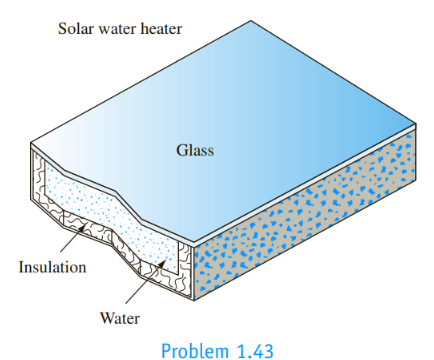
Concept explainers
A simple solar heater consists of a flat plate of glass below which is located a shallow pan filled with water, so that the water is in contact with the glass plate above it. Solar radiation passes through the glass at the rate of

Trending nowThis is a popular solution!

Chapter 1 Solutions
Principles of Heat Transfer (Activate Learning with these NEW titles from Engineering!)
- 2.38 The addition of aluminum fins has been suggested to increase the rate of heat dissipation from one side of an electronic device 1 m wide and 1 m tall. The fins are to be rectangular in cross section, 2.5 cm long and 0.25 cm thick, as shown in the figure. There are to be 100 fins per meter. The convection heat transfer coefficient, both for the wall and the fins, is estimated to be K. With this information determine the percent increase in the rate of heat transfer of the finned wall compared to the bare wall.arrow_forward3.16 A large, 2.54-cm.-thick copper plate is placed between two air streams. The heat transfer coefficient on one side is and on the other side is . If the temperature of both streams is suddenly changed from 38°C to 93°C, determine how long it takes for the copper plate to reach a temperature of 82°C.arrow_forwardHeat is transferred at a rate of 0.1 kW through glass wool insulation (density=100kg/m3) with a 5-cm thickness and 2-m2 area. If the hot surface is at 70C, determine the temperature of the cooler surface.arrow_forward
- A cooling system is to be designed for a food storage warehouse for keeping perishable foods cool prior to transportation to grocery stores. The warehouse has an effective surface area of 1860 m2 exposed to an ambient air temperature of 32C. The warehouse wall insulation (k=0.17W/(mK)) is 7.5 cm thick. Determine the rate at which heat must be removed (W) from the warehouse to maintain the food at 4C.arrow_forward1.60 Two electric resistance heaters with a 20 cm length and a 2 cm diameter are inserted into a well-insulated 40-L tank of water that is initially at 300 K. If each heater dissipates 500 W, what is the time required for bringing the water temperature in the tank to 340 K? State your assumption for your analysis.arrow_forwardHow does the conduction of heat occur in a solid material, and what factors influence the rate of heat transfer through conduction?arrow_forward
- In a new residential project, you strongly believe thatdouble-paned windows are ‘better’ than single-paned windows.Compare the rate of heat loss between single and double-panedwindows (1.5 m x 1 m) if the thickness of each pane is (th = 0.4 cm)and (k = 0.9 W/m.K). The indoor and outdoor temperatures are 18°C and 2 °C, respectively. Thickness of the air gap between thedouble-paned windows is (th = 1 cm), and (k = 0.022 W/m.K).Image credit: Windowwhirl.arrow_forwardAn average person generates heat at a rate of 240 Btu/h while resting in a room at 70°F. Assuming onequarter of this heat is lost from the head and taking the emissivity of the skin to be 0.9, determine the average surface temperature of the head when it is not covered. The head can be approximated as a 12-in-diameter sphere, and the interior surfaces of the room can be assumed to be at the room temperature.arrow_forwardWhat is the heat power lost from the cup to the air due to convection? Take the external surface of a cup (with lid) to be at a temperature of 55.0oC and take the ambient air temperature to be 20.0oC. Take the heat convection coefficient to be 7.10 W/m2K for air. The area of the cup from which heat is transferred to air consists of the lid and the sides of the cup only, where the cup radius is 4.00 cm and its height is 9.20 cm. Give your answer in units of W, accurate to 1 decimal place.arrow_forward
- A 0.083-in-diameter electrical wire at 90°F is covered by 0.02-in-thick plastic insulation (k = 0.075 Btu/ h·ft·°F). The wire is exposed to a medium at 50°F, with a combined convection and radiation heat transfer coefficient of 2.5 Btu/h·ft2·°F. Determine if the plastic insulation on the wire will increase or decrease heat transfer from the wire.arrow_forwardFour power transistors, each dissipating 12 W, are mounted on a thin vertical aluminum plate 22 cm * 22 cm in size. The heat generated by the transistors is to be dissipated by both surfaces of the plate to the surrounding air at 25°C, which is blown over the plate by a fan. The entire plate can be assumed to be nearly isothermal, and the exposed surface area of the transistor can be taken to be equal to its base area. If the average convection heat transfer coefficient is 25 W/m2·K, determine the temperature of the aluminum plate. Disregard any radiation effects.arrow_forwardAt what rate is heat lost through a 1.3m ×2.7m rectangular glass window that is 0.32cm thick when the inside surface temperature of the glass is 22°C and the outside surface temperature of the glass is 16°C? The thermal conductivity of glass is 0.75 W/(m·K)[1m = 100 cm]arrow_forward
 Principles of Heat Transfer (Activate Learning wi...Mechanical EngineeringISBN:9781305387102Author:Kreith, Frank; Manglik, Raj M.Publisher:Cengage Learning
Principles of Heat Transfer (Activate Learning wi...Mechanical EngineeringISBN:9781305387102Author:Kreith, Frank; Manglik, Raj M.Publisher:Cengage Learning
